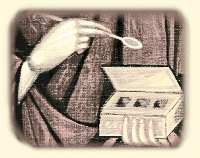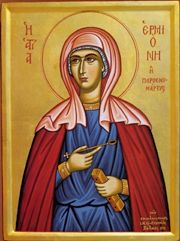Lives of the Female Unmercenary Saints

11 October
THE HOLY UNMERCENARY PHYSICIANS
ZENAIDA AND PHILONELLA, THE FRIENDS OF PEACE

11 October
THE HOLY UNMERCENARY PHYSICIANS
ZENAIDA AND PHILONELLA, THE FRIENDS OF PEACE
So far as we know, the first of the real "unmercenary physicians" were women.
The holy sisters, Zenaida and Philonella were born in the district of Tarsus early in the first century. They were cousins of the Apostle Paul and were born into a highly educated Jewish family. Both sisters had a natural intelligence and a love for learning. When they entered the famous school at Tarsus to study philosophy, the sisters were instantly attracted to the lectures of the medical theorists. Their cousin Jason, Bishop of Tarsus, was an early convert to Christianity and a follower of their kinsman, Apostle Paul.
The two sisters learned the Christian Faith from Saint Jason and were attracted by the love and compassion of Christ. After their baptism, the two gave themselves over more fully to the study of medicine and began to apply Christian principles and ideas to medical philosophy. They understood that salvation is a healing process and they were deeply impressed with the realization that Christ lied the healing of the whole person, spiritual and physical, with the presence of the Heavenly Kingdom.
When Saints Zenaida and Philonalla completed their studies, they moved to Thessally, where there were many medicinal mineral springs flowing in the numerous caverns of the Felion Mountains. Here, the Greeks had centres of pagan worship tied 10 the philosophy of medicine and the worship of Asklepios, the patron of healing. The holy sisters desired to bring the Gospel of Jesus Christ to the great crowds of people who visited these mineral hot springs for healing. Their earnest desire was to combine scientific medicine with prayer and faith and so reveal the nature of salvation and proclaim Jesus Christ to whomever would hear the words of the glorious Gospel.
Finding a cavern with a mineral spring, Zenaida and Philonella built two cells and a small chapel for themselves. Having thus established a women's monastery, they used their wealth to create a clinic. The pagan physicians not only sought out the wealthy and generally ignored the poor, but they mixed their medical practice with magic, superstition and witchcraft. Much money was earned from the sale of medical amulets, charms and useless compounds. The two sisters opened their hearts to the poor.
Philonella was a patient and careful scholar. Almost at once she set herself to developing experimental medicine which would approach a scientific medicine.
All her life she would labor to free medicine from the idea of magic, astrology and superstition. Zenaida, on the other hand, was more contemplative. She was keenly interested in the suffering of children and worked to develop pediatric care, but her first love was monasticism. So famous did she become as a spiritual elder that both men and women sought her spiritual counsel. Three of her spiritual children, Papias, Pateras and Philocyrus built a men's monastery not far from the cavern-hospital of the holy sisters.
The sisters' love, compassion and openness to the poor and humble attracted many to the faith of our Lord Jesus Christ and nut only the medical skill of the two sisters became renowned, but the miracles worked through their prayers established many in the Gospel.
Toward the end of her life, Saint Zenaida became interested in psychiatric medicine. Many of those who came to their hospital suffered from severe depression and other psychiatric illnesses. Zenaida had the wisdom to recognize these as actual illnesses and concerned herself with their causes and cure.
It is not known in what year Saint Zenaida departed this life, but she left her sister Philonella to carry on their work and instruct others in Cluistian medicine and the faith. After the death of her beloved sister, Philonella entered more deeply into the spiritual life, leaving the treatment and care of patients more and more to the students and other nuns. She also became renowned as a wonderworker and reposed in peace and at a great age. The Holy Church bestowed the title, "Friends of Peace" on the two saints because they both preached and practiced peace, serenity and charity. Philonella often said that a peaceful and serene disposition could not only aid in healing but could even prevent illness. For her, the source of true peace was the Holy Spirit and the Gospel of Jesus Christ, the Prince of Peace. The disciples of Saint Zenaida reported that her last words in this life were a prayer for the peace of the world.
Not only were Saints Zenaida and Philonella the first Christian doctors (after Apostle Luke), but they were the first of those saints whom we call "unmercenary physicians"; Christian medicine began with holy women.

September 4
HOLY UNMERCENARY PHYSICIAN
SAINT HERMIONE THE MARTYR
Founder of Christian Xenodolion (hospital-inn)
Our holy mother Hermione was a daughter of Saint Philip the Deacon (Acts chapter 6). She was born in Caesarea of Palestine early in the first century. Inspired by a true understanding of the Gospel, she studied the philosophy of medicine in her native city. After the Christians were driven out of Palestine, Saint Hermione traveled to Ephesus to seek out the beloved Apostle John. By the time she arrived, the great evangelist had already departed this life.
Joined by heir sister Eukhidia, Saint Hermione bought a house and founded a medical clinic, devoted to the treatment of the poor and the homeless. Soon, she added rooms for these homeless ones and for poor travelers who were ill. Thus was established the first of those hospital-hostels or "xenodukia", which would become so much a part of the Orthodox Christian tradition. Like the other unmercenary physicians who would come after her, she understood that salvation consisted in the healing and liberation of the whole person - body and soul together. While ministering to the physical illnesses of those who came to her, the saint also nourished them with the Gospel and led them to that true healing and freedom in Jesus Christ.
Filled with the grace of the Holy Spirit, Saint Hermione was given gift of prophecy and became a link in that chain of New Testament prophets who were united in spirit and calling to the great Old Testament prophets. After a long life of service as physician, evangelist and prophet, Saint Hermione was granted the crown of martyrdom. During the reign of Emperors Trajan and Hadrian, she was arrested and, in spite of her great old age and renown, subjected to terrible tortures in an effort to force her to renounce our Lord Jesus Christ. She was beheaded on September the fourth and received the glorious crown of those who choose everlasting life in our Lord Jesus Christ above this transitory earthly life.
Through her holy prayers, may we also find healing and salvation.
From "Lives of the Saints", Vol. 11
Synaxis Press
Reprinted with the kind permission of Archbishop Lazar Puhalo